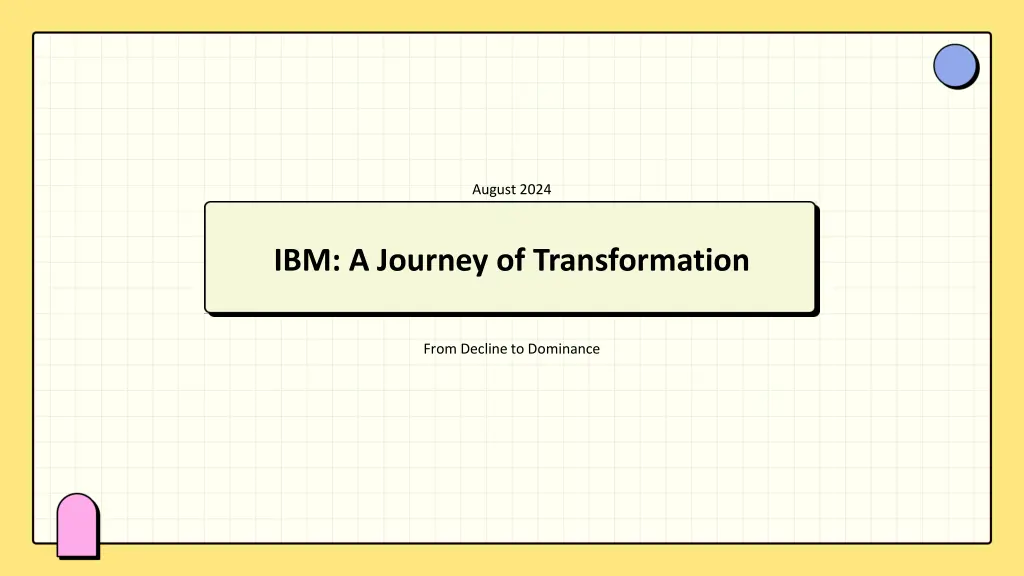
IBM Transformation: From Decline to Dominance in August 2024
Discover IBM's journey from decline to dominance as it overcomes challenges, embraces innovation, and adapts to changing market landscapes. Explore the foundation, milestones, and challenges faced by IBM on its path to success.
Download Presentation

Please find below an Image/Link to download the presentation.
The content on the website is provided AS IS for your information and personal use only. It may not be sold, licensed, or shared on other websites without obtaining consent from the author. If you encounter any issues during the download, it is possible that the publisher has removed the file from their server.
You are allowed to download the files provided on this website for personal or commercial use, subject to the condition that they are used lawfully. All files are the property of their respective owners.
The content on the website is provided AS IS for your information and personal use only. It may not be sold, licensed, or shared on other websites without obtaining consent from the author.
E N D
Presentation Transcript
August 2024 IBM: A Journey of Transformation From Decline to Dominance
Table of Contents 5 The 1993 Crisis 1 The Rise of IBM 6 A New Leadership Era 2 Foundation and Origins Innovative Milestones 7 Shifting Business Focus 3 Challenges in the Late 20th Century 8 Strategic Divestitures 4
9 Embracing Future Technologies 10 A Legacy of Adaptability
The Rise of IBM 1. IBM stands as a testament to resilience, overcoming challenges of the past to redefine the tech landscape. 2. Founded over a century ago, IBM has continuously innovated, adjusting to market needs while maintaining its core values. 3. Despite facing significant hurdles in the 1990s, it emerged stronger than ever, proving the power of adaptability. Photo by Pexels 4. Understanding its history provides insights into the business world's evolution and the critical importance of innovation.
Foundation and Origins 1. Herman Hollerith s tabulating machine laid the groundwork for what would become IBM in the late 19th late 19th century. 2. The formation of the Tabulating Machine Company marked the genesis of IBM s journey into technology and innovation. 3. In 1911, the merger of various companies created CTR, which would later evolve into International Business Photo by Pexels Machines in 1924. 4. Thomas J. Watson Sr.'s vision set a strong foundation focused on exceptional customer service and technological prowess.
Innovative Milestones 1. IBM's introduction of System/360 in 1964 revolutionized revolutionized enterprise computing, establishing a new a new industry standard. 2. The launch of the IBM PC in 1981 positioned the company as a leader, despite outsourcing its OS to Microsoft. 3. These innovations were crucial in defining the computer market and solidifying IBM's role in technology Photo by Pexels advancement. 4. Yet, these successes also highlighted early challenges of adaptation in a rapidly changing market landscape.
Challenges in the Late 20th Century Century 1. By the late 1990s, IBM's internal issues, including complacency, led to a decline in market relevance and and efficiency. 2. Bureaucratic structures slowed innovation, hindering timely decision-making and responsiveness to customer needs. 3. The company struggled to transition from mainframes to personal computing, missing crucial market shifts. Photo by Pexels 4. Reliance on hardware overshadowed the emerging importance of software and services in the tech ecosystem.
The 1993 Crisis 1. In 1993, IBM reported a staggering $8 billion loss, a result a result of its size and bureaucratic entanglements. entanglements. 2. This crisis was a wake-up call, highlighting the urgent need for change and innovation within the company. 3. The looming threat of bankruptcy forced IBM to reassess its strategies and values in the tech industry. Photo by Pexels 4. This period marked a pivotal turning point in IBM's history, demanding a radical shift in direction and vision.
A New Leadership Era 1. Louis V. Gerstner Jr. took the helm during this tumultuous tumultuous time, redefining company culture and direction. 2. His focus on customer service and innovation revitalized IBM s commitment to meeting market demands. 3. Gerstner's leadership style encouraged collaboration and creativity, breaking down bureaucratic barriers within IBM. Photo by Pexels 4. This new vision was essential for IBM's recovery and resurgence in the tech landscape.
Shifting Business Focus 1. Under Gerstner s leadership, IBM pivoted from hardware - hardware- centric to a service and software-driven business model. 2. The expansion of the Global Services division positioned IBM as a leading provider of technology solutions. 3. This strategic shift opened new revenue streams and adapted to changing market dynamics effectively. Photo by Pexels 4. Emphasizing services allowed IBM to capture growing demand for software solutions in the tech industry.
Strategic Divestitures 1. IBM recognized the need to divest from non-core businesses, selling its PC division to Lenovo. 2. Exiting commoditized markets enabled IBM to streamline its focus on high-value tech offerings and services. 3. This strategic decision emphasized commitment to innovation and market leadership in technology. 4. Focusing on core strengths allowed IBM to regain agility Photo by Pexels and adaptability in a competitive environment.
Embracing Future Technologies Technologies 1. In the face of challenges, IBM invested heavily in emerging technologies like cloud computing and AI. AI. 2. This shift towards innovation positioned IBM to lead in groundbreaking technologies like quantum computing. 3. IBM's commitment to research and development is evident in its continued advancements and industry leadership. Photo by Pexels 4. These strategic investments reflect the company's belief in leveraging technology for future growth and sustainability.
A Legacy of Adaptability 1. IBM's evolution highlights the critical role of adaptability adaptability in overcoming adversity and driving success success in technology. 2. Strong leadership, like that of Gerstner, can transform a company's trajectory and redefine its future. 3. Innovation remains the lifeblood of technology companies, requiring constant reassessment and evolution. Photo by Pexels 4. IBM's journey is an inspiring example for businesses aiming to navigate change and thrive in competitive landscapes.
